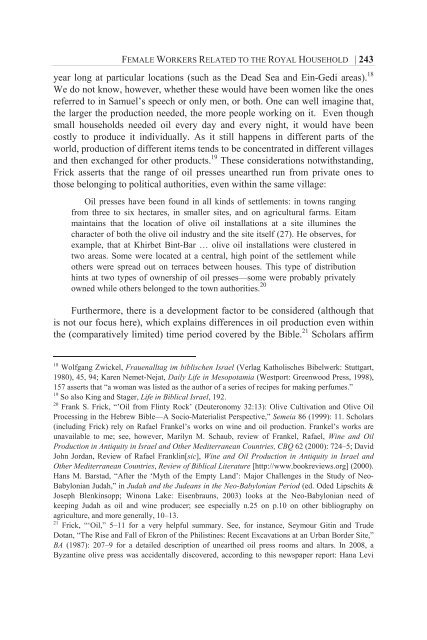Women at Work in the Deuteronomistic History - International Voices ...
Women at Work in the Deuteronomistic History - International Voices ...
Women at Work in the Deuteronomistic History - International Voices ...
You also want an ePaper? Increase the reach of your titles
YUMPU automatically turns print PDFs into web optimized ePapers that Google loves.
FEMALE WORKERS RELATED TO THE ROYAL HOUSEHOLD | 243<br />
year long <strong>at</strong> particular loc<strong>at</strong>ions (such as <strong>the</strong> Dead Sea and E<strong>in</strong>-Gedi areas). 18<br />
We do not know, however, whe<strong>the</strong>r <strong>the</strong>se would have been women like <strong>the</strong> ones<br />
referred to <strong>in</strong> Samuel’s speech or only men, or both. One can well imag<strong>in</strong>e th<strong>at</strong>,<br />
<strong>the</strong> larger <strong>the</strong> production needed, <strong>the</strong> more people work<strong>in</strong>g on it. Even though<br />
small households needed oil every day and every night, it would have been<br />
costly to produce it <strong>in</strong>dividually. As it still happens <strong>in</strong> different parts of <strong>the</strong><br />
world, production of different items tends to be concentr<strong>at</strong>ed <strong>in</strong> different villages<br />
and <strong>the</strong>n exchanged for o<strong>the</strong>r products. 19 These consider<strong>at</strong>ions notwithstand<strong>in</strong>g,<br />
Frick asserts th<strong>at</strong> <strong>the</strong> range of oil presses unear<strong>the</strong>d run from priv<strong>at</strong>e ones to<br />
those belong<strong>in</strong>g to political authorities, even with<strong>in</strong> <strong>the</strong> same village:<br />
Oil presses have been found <strong>in</strong> all k<strong>in</strong>ds of settlements: <strong>in</strong> towns rang<strong>in</strong>g<br />
from three to six hectares, <strong>in</strong> smaller sites, and on agricultural farms. Eitam<br />
ma<strong>in</strong>ta<strong>in</strong>s th<strong>at</strong> <strong>the</strong> loc<strong>at</strong>ion of olive oil <strong>in</strong>stall<strong>at</strong>ions <strong>at</strong> a site illum<strong>in</strong>es <strong>the</strong><br />
character of both <strong>the</strong> olive oil <strong>in</strong>dustry and <strong>the</strong> site itself (27). He observes, for<br />
example, th<strong>at</strong> <strong>at</strong> Khirbet B<strong>in</strong>t-Bar … olive oil <strong>in</strong>stall<strong>at</strong>ions were clustered <strong>in</strong><br />
two areas. Some were loc<strong>at</strong>ed <strong>at</strong> a central, high po<strong>in</strong>t of <strong>the</strong> settlement while<br />
o<strong>the</strong>rs were spread out on terraces between houses. This type of distribution<br />
h<strong>in</strong>ts <strong>at</strong> two types of ownership of oil presses—some were probably priv<strong>at</strong>ely<br />
owned while o<strong>the</strong>rs belonged to <strong>the</strong> town authorities. 20<br />
Fur<strong>the</strong>rmore, <strong>the</strong>re is a development factor to be considered (although th<strong>at</strong><br />
is not our focus here), which expla<strong>in</strong>s differences <strong>in</strong> oil production even with<strong>in</strong><br />
<strong>the</strong> (compar<strong>at</strong>ively limited) time period covered by <strong>the</strong> Bible. 21 Scholars affirm<br />
18 Wolfgang Zwickel, Frauenalltag im biblischen Israel (Verlag K<strong>at</strong>holisches Bibelwerk: Stuttgart,<br />
1980), 45, 94; Karen Nemet-Nej<strong>at</strong>, Daily Life <strong>in</strong> Mesopotamia (Westport: Greenwood Press, 1998),<br />
157 asserts th<strong>at</strong> “a woman was listed as <strong>the</strong> author of a series of recipes for mak<strong>in</strong>g perfumes.”<br />
19 So also K<strong>in</strong>g and Stager, Life <strong>in</strong> Biblical Israel, 192.<br />
20 Frank S. Frick, “’Oil from Fl<strong>in</strong>ty Rock’ (Deuteronomy 32:13): Olive Cultiv<strong>at</strong>ion and Olive Oil<br />
Process<strong>in</strong>g <strong>in</strong> <strong>the</strong> Hebrew Bible—A Socio-M<strong>at</strong>erialist Perspective,” Semeia 86 (1999): 11. Scholars<br />
(<strong>in</strong>clud<strong>in</strong>g Frick) rely on Rafael Frankel’s works on w<strong>in</strong>e and oil production. Frankel’s works are<br />
unavailable to me; see, however, Marilyn M. Schaub, review of Frankel, Rafael, W<strong>in</strong>e and Oil<br />
Production <strong>in</strong> Antiquity <strong>in</strong> Israel and O<strong>the</strong>r Mediterranean Countries, CBQ 62 (2000): 724–5; David<br />
John Jordan, Review of Rafael Frankl<strong>in</strong>[sic], W<strong>in</strong>e and Oil Production <strong>in</strong> Antiquity <strong>in</strong> Israel and<br />
O<strong>the</strong>r Mediterranean Countries, Review of Biblical Liter<strong>at</strong>ure [http://www.bookreviews.org] (2000).<br />
Hans M. Barstad, “After <strong>the</strong> ‘Myth of <strong>the</strong> Empty Land’: Major Challenges <strong>in</strong> <strong>the</strong> Study of Neo-<br />
Babylonian Judah,” <strong>in</strong> Judah and <strong>the</strong> Judeans <strong>in</strong> <strong>the</strong> Neo-Babylonian Period (ed. Oded Lipschits &<br />
Joseph Blenk<strong>in</strong>sopp; W<strong>in</strong>ona Lake: Eisenbrauns, 2003) looks <strong>at</strong> <strong>the</strong> Neo-Babylonian need of<br />
keep<strong>in</strong>g Judah as oil and w<strong>in</strong>e producer; see especially n.25 on p.10 on o<strong>the</strong>r bibliography on<br />
agriculture, and more generally, 10–13.<br />
21 Frick, “‘Oil,” 5–11 for a very helpful summary. See, for <strong>in</strong>stance, Seymour Git<strong>in</strong> and Trude<br />
Dotan, “The Rise and Fall of Ekron of <strong>the</strong> Philist<strong>in</strong>es: Recent Excav<strong>at</strong>ions <strong>at</strong> an Urban Border Site,”<br />
BA (1987): 207–9 for a detailed description of unear<strong>the</strong>d oil press rooms and altars. In 2008, a<br />
Byzant<strong>in</strong>e olive press was accidentally discovered, accord<strong>in</strong>g to this newspaper report: Hana Levi




